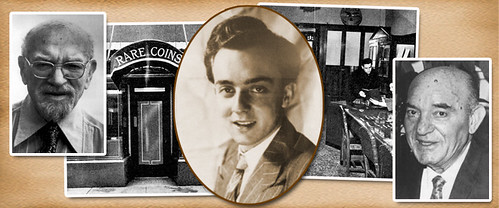
PREV ARTICLE
NEXT ARTICLE
FULL ISSUE
PREV FULL ISSUE
HARVEY STACK'S NUMISMATIC FAMILY, PART 8Harvey Stack's latest Stack's Bowers blog series focuses on growing up in a numismatic family. Here's part 8, published December 27, 2017. -Editor
 By 1950, we in the coin business had seen many changes. The post-war period brought many coins from overseas to our shores. Servicemen who were in the war returned home with packages and in some cases duffle bags of coins. Museums and private collections were destroyed by the war and among the ruins were coins scattered about. Many of these came to our shores and were sold. Those that were silver and gold had intrinsic value, and those of obvious scarcity and rarity had more value. So in a few years the market here in America was flush with coins from all ages, ancient to modern times. In addition, the U.S. Mint made several new commemoratives. One was for the State of Iowa, in 1946, and this issue spurred interest in classic commemorative half dollars, the 47 different issues struck from 1892 to 1939. Collectors flocked to add them to their sets. Also from 1946 to 1951 a series of commemorative half dollars honoring Booker T. Washington was struck each year at all three U.S. mints, and in 1951 the Carver-Washington commemorative half dollars were struck, also at three mints. These were issued until 1954. Again, the more designs offered the more the interest grew. In 1950, the U.S. Mint decided to start issuing Proof sets containing coins of each denomination from the cent to the half dollar. Proof set production had been suspended due to the war after 1942, and none were struck until 1950. The new sets were sold for $2.10 each, which included 91 cents in face value. Reasonably priced, for sure! Also starting in 1946 the U.S. Mint issued a newly designed dime with the portrait of Franklin Delano Roosevelt. These were struck at three mints and became favorites of new collectors who sought them out in change. The same thing occurred when the Benjamin Franklin half dollar was issued starting in 1948. These series gave collectors the opportunity to start with the very first years a design was issued. All of these things contributed to growing interest in collecting coins and the collector base expanded. Of course, the nation’s economy improved after the war and more people had money to pursue numismatics. All this increased demand for service at Stack's and we expanded the staff to be able to serve all. Many collectors came to Stack’s, mostly on weekends, to help sort coins, catalog them, and also learn more about areas they were interested in. The business demanded many different skills and a certain level of flexibility. It was important to take advantage of opportunities as they came up. My uncle, Joseph, hated to drive so when he got a call from an old bank in Bridgeton, New Jersey, he got my father, Norman, to drive him there. The bank had been established in 1830. When they arrived at the bank they were shown bags of silver coins that, according to the banker, had been there since 1836 or so. In the bags they found hoards of half dollars dated before 1837, the date when the design was modified, the edges milled, (rather than lettered) and the weight of the coins reduced. It seems the early bankers had decided to save all the earlier half dollars that came in the bank, thinking their higher weight might make them more valuable later on. Joe and Norman bought over 10,000 specimens from the banker, as the numismatic value in 1950 was quite a bit greater than the silver content. So they paid the banker, thanked him for calling, and the two drove back to New York, where the rest of us in the store were amazed. These half dollars were sorted first by date, by grade and by obvious varieties, and were placed in 2 x 2 envelopes with the date and grade on the outside. We started to offer these for sale in our price lists and auction sales. No one could believe how many we had; it was a great numismatic find. Al Overton, a dealer, collector and author who specialized in these coins, visited Stack's a number of times, to review the issues prior to 1836 and record many of the varieties that showed up in this hoard, He later included these in his important reference book on early half dollars. What a great haul! Amazing. -Editor
To read the complete article, see:  Wayne Homren, Editor The Numismatic Bibliomania Society is a non-profit organization promoting numismatic literature. See our web site at coinbooks.org. To submit items for publication in The E-Sylum, write to the Editor at this address: whomren@gmail.com To subscribe go to: https://my.binhost.com/lists/listinfo/esylum All Rights Reserved. NBS Home Page Contact the NBS webmaster 
|